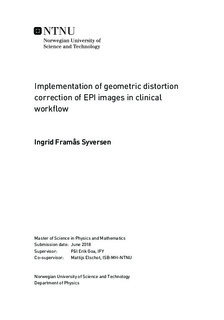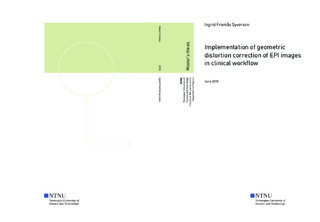| dc.description.abstract | Background: Geometric distortion in echo-planar (EPI) magnetic resonance (MR) images, caused by low bandwidth combined with variations in magnetic susceptibility, is a problem that can make it challenging to connect functional MR data to anatomical position. A distortion correction method based on the acquisition of images with opposing phase encoding directions has been successfully used at NTNU for several years. However, this method can currently only be performed offline on anonymised images and is therefore not used in clinical routine. The aim of this master's project was to implement and test this method in the clinical software environment of syngo.via Frontier.
Materials and methods: A prototype for distortion correction was made in MeVisLab and installed in syngo.via Frontier. It was tested on diffusion-weighted EPI images from 13 breast and 16 prostate patients, and the images were examined visually to determine the robustness in terms of percentage non-failed corrections, and the quality of corrections. Various image similarity metrics were also calculated in order to try to determine the quality of corrections quantitatively. To assess the user-friendliness of the prototype, it was tested by a radiographer and a medical physicist.
Results: None of the corrections failed, giving a robustness of 100%. By visual assessment, the quality of correction was determined to be successful for 12 of 13 breast patients and all 16 prostate patients. The calculated metrics generally showed good results for the breast images, but they gave some inconclusive results for the prostate images. The feedback from the user-friendliness testing showed that after minimal training it would be relatively easy to use the prototype.
Conclusion: The prototype was able to successfully correct geometrically distorted images. Nevertheless, the calculated metrics yielded varying results, and more investigations should therefore be performed to find suitable metrics for determining the quality of corrections quantitatively. Although there is still room for improvements, the prototype has potential to be an easy-to-use tool for geometric distortion correction of EPI images in clinical workflow. | |

